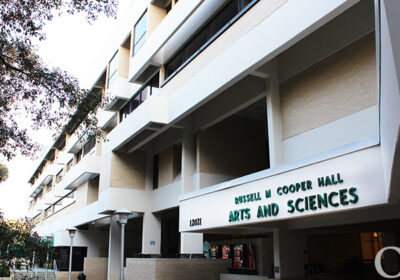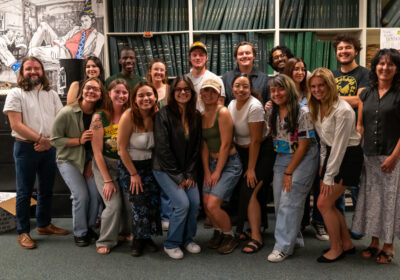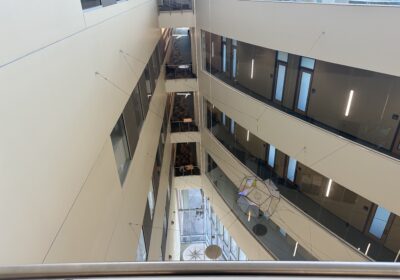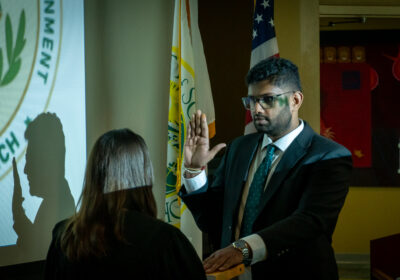Research vessel docked at St. Pete campus gives students mentorship opportunities

Some USF students will have the opportunity to utilize the Florida Institute of Oceanography’s (FIO) research vessel, the Western Flyer, after it was gifted to St. Pete by the Monterey Bay Aquarium Research Institute.
Students involved in Peerside, an FIO peer-mentorship program developed to broaden student access to ocean science, will be able to conduct ship-to-shore research alongside FIO mentors, according to FIO Director Monty Graham.
Peerside was launched in the summer of 2023 and, during the Western Flyer’s initial voyages, worked with graduate students to improve the program for this school year’s class.
“We had students from all over who came in to participate in the program and they were incredibly insightful and helpful because this was their shakedown. This is the first time we’re running the program. We were working with them in ways that they can help us develop the program better for the future,” Graham said.
The Western Flyer, alongside Weatherbird II and Hogarth, will strengthen the St. Pete campus’ prominent environmental and oceanographic sciences programs, according to Assistant Regional Vice Chancellor Carrie O’Brion. The ship includes two remote operated vehicles (ROV), a wet lab and a moon pool for researchers.
The ship also supports all of the State University System colleges, which can request time with each ship for research, according to Assistant Regional Vice Chancellor Carrie O’Brion.
“They will obviously go out in the ocean and do research there. But there may be opportunities to come collaborate with our faculty so they can do cross-institutional research,” O’Brion said.
The two unmanned ROVs allow researchers and students to remotely explore the depths of the ocean, with the suitcase-sized vehicle able to explore close to 200 meters below sea level. A third, larger ROV is expected to be added to the ship in May of 2024, which will allow researchers to explore 4,000 meters under the sea, according to Graham.
Allowing researchers to explore beyond Florida’s waters, the Western Flyer is able to conduct expeditions into waters off the southeastern U.S. and into the northern Caribbean Sea. The ship’s dynamic positioning system, combined with the small waterplane area twin hull (SWATH) design, ensures stability in the water for researchers during these expeditions.
The operation of the ship is funded through grants by the Office of Naval Research and FIO and state appropriations through USF, creating no additional cost to USF students.
After a 4,000-mile journey from California, through the Panama Canal and the Gulf of Mexico, the Western Flyer docked at its homebase in St. Pete on July 12 and became the newest addition to the FIO fleet.
USF was designated the host institution for FIO in 2009 and, as part of their continuing partnership, allows FIO staff and researchers to operate the Western Flyer and two other ships housed at USF, according to Graham.
“No other institution has ever hosted FIO, so we have a long-standing relationship with the university. We have had very strong and very positive interactions with USF and they have been very supportive of that strategic area USF has designed around ocean science’s sustainability,” Graham said.
When the ship docked, half of the students in the peerside program worked on the vessel and the other half worked on shore before switching roles. This allowed students to learn both the sea and shore aspects of oceanic research, which Graham said was one of the most valuable parts of the program.
USF clubs and groups and local middle and high schools will have the opportunity to visit the vessels, located near USF St. Pete’s Center of Excellence of the Environmental and Oceanographic Sciences Research and Teaching Facility (EOS). The EOS is currently under construction.
“At the end of the day, that is part of it being the crown jewel of the space. We already have phenomenal spaces, but it is a matter of expanding those and increasing the profile of the program and doing more about coastal resiliency, flooding, tides and marine life,” O’Brion said.
While the Western Flyer is not a part of the EOS, O’Brion said it will complement the facility and improve the reputation of the programs at St. Pete’s campus.
O’Brion said the Western Flyer will call the St. Pete campus home for the foreseeable future. The boat arrived in May, but went into a dry dock storage to undergo maintenance, such as repainting the vessel.
“This is really about education and training in order to have a more robust understanding of these career opportunities and to continue pursuing innovation and discovery in the area of oceanographic studies,” O’Brion said.







